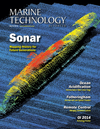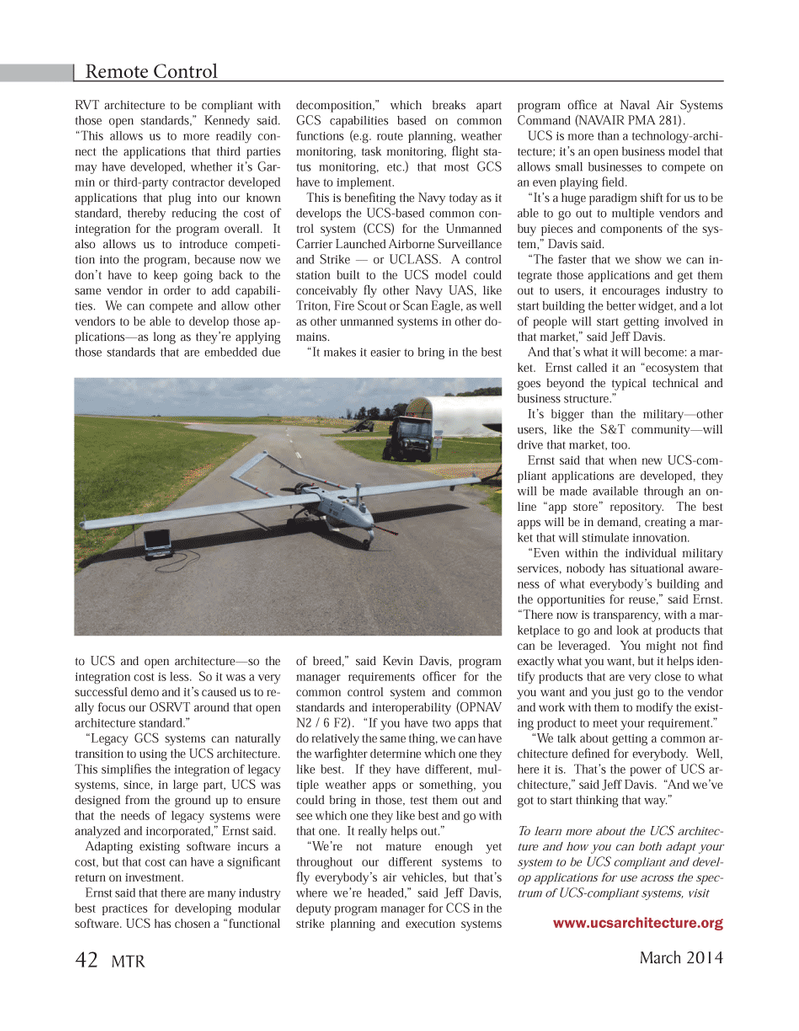
Page 42: of Marine Technology Magazine (March 2014)
Instrumentation: Measurement, Process & Analysis
Read this page in Pdf, Flash or Html5 edition of March 2014 Marine Technology Magazine
RVT architecture to be compliant with those open standards,? Kennedy said. ?This allows us to more readily con- nect the applications that third parties may have developed, whether it?s Gar- min or third-party contractor developed applications that plug into our known standard, thereby reducing the cost of integration for the program overall. It also allows us to introduce competi- tion into the program, because now we don?t have to keep going back to the same vendor in order to add capabili- ties. We can compete and allow other vendors to be able to develop those ap- plications?as long as they?re applying those standards that are embedded due to UCS and open architecture?so the integration cost is less. So it was a very successful demo and it?s caused us to re- ally focus our OSRVT around that open architecture standard.? ?Legacy GCS systems can naturally transition to using the UCS architecture. This simpli es the integration of legacy systems, since, in large part, UCS was designed from the ground up to ensure that the needs of legacy systems were analyzed and incorporated,? Ernst said. Adapting existing software incurs a cost, but that cost can have a signi cant return on investment. Ernst said that there are many industry best practices for developing modular software. UCS has chosen a ?functional decomposition,? which breaks apart GCS capabilities based on common functions (e.g. route planning, weather monitoring, task monitoring, ight sta- tus monitoring, etc.) that most GCS have to implement. This is bene ting the Navy today as it develops the UCS-based common con- trol system (CCS) for the Unmanned Carrier Launched Airborne Surveillance and Strike ? or UCLASS. A control station built to the UCS model could conceivably y other Navy UAS, like Triton, Fire Scout or Scan Eagle, as well as other unmanned systems in other do-mains.?It makes it easier to bring in the best of breed,? said Kevin Davis, program manager requirements of cer for the common control system and common standards and interoperability (OPNAV N2 / 6 F2). ?If you have two apps that do relatively the same thing, we can have the war ghter determine which one they like best. If they have different, mul- tiple weather apps or something, you could bring in those, test them out and see which one they like best and go with that one. It really helps out.? ?We?re not mature enough yet throughout our different systems to y everybody?s air vehicles, but that?s where we?re headed,? said Jeff Davis, deputy program manager for CCS in the strike planning and execution systems program of ce at Naval Air Systems Command (NAVAIR PMA 281). UCS is more than a technology-archi-tecture; it?s an open business model that allows small businesses to compete on an even playing eld.?It?s a huge paradigm shift for us to be able to go out to multiple vendors and buy pieces and components of the sys- tem,? Davis said. ?The faster that we show we can in- tegrate those applications and get them out to users, it encourages industry to start building the better widget, and a lot of people will start getting involved in that market,? said Jeff Davis. And that?s what it will become: a mar- ket. Ernst called it an ?ecosystem that goes beyond the typical technical and business structure.? It?s bigger than the military?other users, like the S&T community?will drive that market, too. Ernst said that when new UCS-com- pliant applications are developed, they will be made available through an on- line ?app store? repository. The best apps will be in demand, creating a mar- ket that will stimulate innovation. ?Even within the individual military services, nobody has situational aware- ness of what everybody?s building and the opportunities for reuse,? said Ernst. ?There now is transparency, with a mar- ketplace to go and look at products that can be leveraged. You might not nd exactly what you want, but it helps iden- tify products that are very close to what you want and you just go to the vendor and work with them to modify the exist- ing product to meet your requirement.? ?We talk about getting a common ar- chitecture de ned for everybody. Well, here it is. That?s the power of UCS ar- chitecture,? said Jeff Davis. ?And we?ve got to start thinking that way.? To learn more about the UCS architec- ture and how you can both adapt your system to be UCS compliant and devel- op applications for use across the spec- trum of UCS-compliant systems, visit www.ucsarchitecture.org Remote Control March 2014 42 MTRMTR #2 (34-49).indd 42MTR #2 (34-49).indd 422/21/2014 11:10:30 AM2/21/2014 11:10:30 AM

 41
41

 43
43
